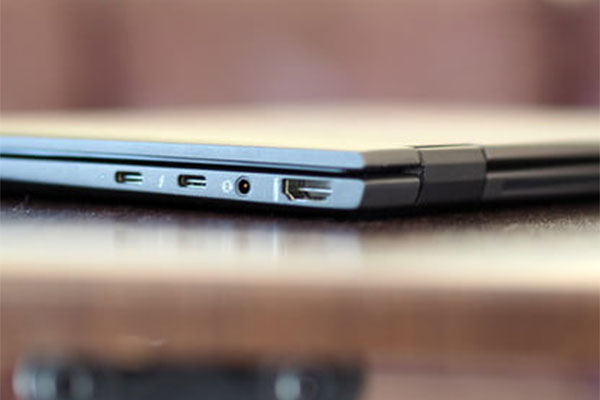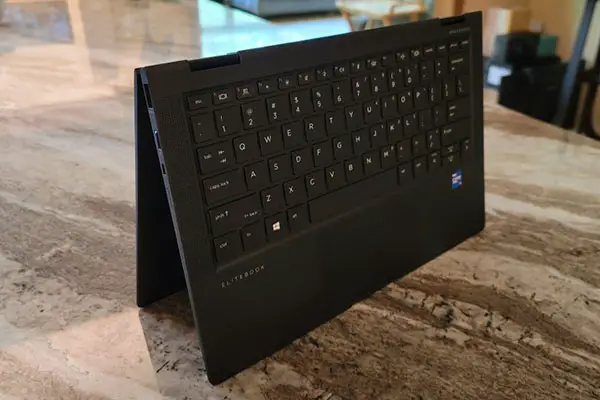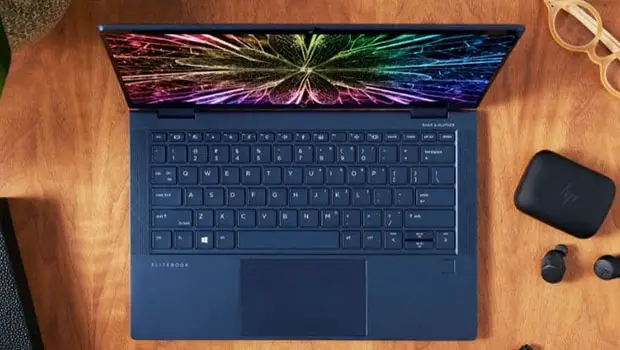Stunning, Powerful and Stowable
Previously, we reviewed HP’s Envy x360 15, an $800 laptop that was too good to be a consumer machine. The company recently sent us one of their latest, the Elite Dragonfly Max Notebook. The Dragonfly Max is a whopping $2200 premium notebook. It is small, gorgeous and packed with power.
Absolutely Stunning
I fell in love with this beautiful machine as soon as I saw it. The Dragonfly Max is an ultra-light notebook weighing just 2.49 pounds. It measures 11.98 by 7.78 inches and is as portable as it can get. The body is a gorgeous jet black and is only 0.63 inches thick. It is fairly simple with one generous-sized and two smaller vents on its underside.
The Dragonfly Max is extremely minimal in terms of IO ports. It hosts two Thunderbolt 4 USB4 Type-C ports, out of which one is for power delivery. There’s a SuperSpeed Type-A port, a headphone and mic combo jack and an HDMI port. The power on button is also located in the row of ports that’s not a usual sight.
HP’s latest notebook is made of light but sturdy plastic. The body feels as light as a feather in your hands but, at the same time, it doesn’t feel cheap. It is robust and solid. The matte body is contrasts nicely with the glossy HP logo on the hood.

Insane Brightness Score
While the Dragonfly Max’s display isn’t anything special, its brightness has an insanely high 1000-nit score. So, you can count on the notebook for providing you with excellent performance across intense sun light. The device does a fairly good job at avoiding glare with its anti-glare technology as well. It has pretty good viewing angles so the colors don’t distort when you turn the screen to a 180-degree angle.
The FHD screen measures 13.3 inches and has a resolution of 1920×1080. It leverages touch-screen technology and is coated by the Corning Gorilla Glass 5. The touch interface sports sufficient responsiveness and registers touch quite well. The Corning coating is glossy, as opposed to matte displays which host better viewing angles normally, but those on the Dragonfly Max aren’t too bad either. The screen also leverages the HP Sure View Reflect Privacy, which is HP’s relatively new privacy feature that immediately transitions the PC to privacy mode, which reduces up to 95 percent of visible light when viewed at an angle, making it difficult for others to view information on the screen.
The Dragonfly Max hosts the Intel Iris Xe graphics. Announced with the Tiger Lake CPUs last year, the Iris Xe is Intel’s latest integrated graphics unit. From the gaming side of things, I found it to support most light to medium-intensity games but it was a slight miss for the more graphic-intensive ones. More on this in the performance section. We’re all aware of how an integrated graphics card will never be as efficient as a dedicated one. On top of that, the Iris Xe provides only a modest improvement over the performance of the graphics silicon that is already built into the chip giant’s latest Tiger Lake CPU. Hence, a lot wasn’t expected from it anyway.

Brilliant Performance at the Cost of a Short Battery Life
The Dragonfly Max sports the specs of a tech junkie’s dream. It has, quite literally, the best of everything. It hosts the Windows 10 Pro 64, which the company itself recommends for business needs. The processor is Intel i7 with multiple RAM and ROM options which range from 16 to 32GB and 512GB to 2TB on its solid state drives. One version of the notebook hosts a clock speed of 2.8GHz that goes up to 4.6GHz with Intel Turbo Boost Technology. It has a 12MB L3 cache and four cores. The other version hosts a clock speed of 3.0GHz that goes up to 4.8GHz. On paper, the Dragonfly Max sports a 4-cell, 56-WHr long life battery.
While the processor specs, in theory, look very tempting, they didn’t give me a fantastic time. While the display didn’t lag terribly, I experienced some latency in its response. Multi-tasking was fairly good. I could easily switch between tabs without it being annoying. ROM options on the Dragonfly Max are pretty generous and it’s highly unlikely that you’ll face any issues there.
With a sufficiently fast clock speed and cache, programs open up fairly fast on this device. I was able to restore previously-closed apps in milliseconds too. Multitasking between work apps, YouTubing and a lot of Disney+ binging lasted me a total of 10 hours on the Dragonfly Max. While that’s not an insanely long battery life, considering I was using the laptop for video-based content and it was set at max brightness, I find it pretty impressive.

Full-Sized Keyboard and Multi-Touch Trackpad
The Dragonfly Max has a well-sized tenkeyless keyboard that features sufficiently good travel. It sports responsive actuation and a couple of dedicated function keys. The keyboard is backlit with two brightness options of the backlight. It is also spill-resistant so you can be a little relaxed with liquids around it.
The Clickpad on the Dragonfly Max features multi-touch gesture support. It is a fairly large trackpad situated right in the center. It has great sensitivity and almost zero input lag.
Miscellaneous
The HP Dragonfly Max sports an integrated infra-red camera of 5MP. There’s also a dual array digital mic. I found the camera to be slightly below average than the cameras I’ve seen on other contemporary laptops. I’m aware of how laptops don’t usually sport HD cameras so I already had low expectations. But even according to those expectations, I was just a little disappointed. For audio, the laptop makes use of Bank & Olufsen-branded four stereo speakers. The sound on this device is solid. It is powerful, punch and crisp. The laptop comes with an AT&T sim card included which, I believe, is quite generous of the company. There’s also a whopping three-year warranty. All in all, this is a fairly generous package for around two thousand bucks.
Is It Hardcore?
Sure.
The Dragonfly Max leverages excellent multitasking and response time. It has a gorgeous body, fantastic privacy settings and a beautiful, bright display. It may be pricey but there’s a reason for it.


























